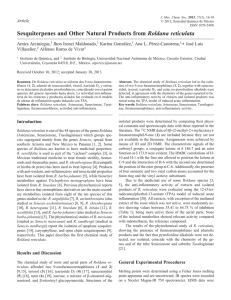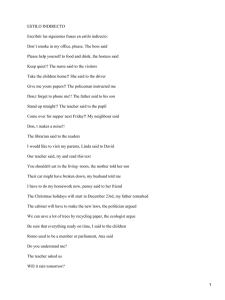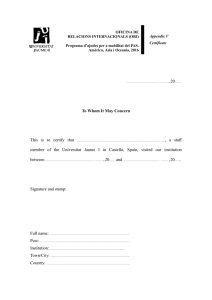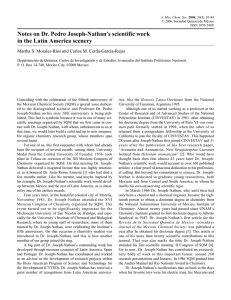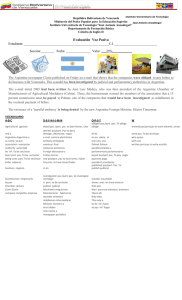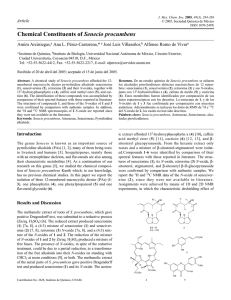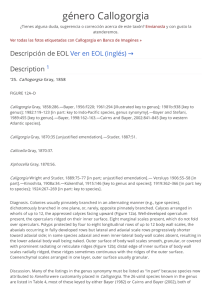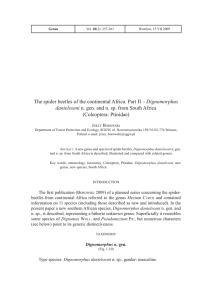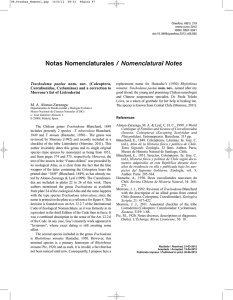Secondary Metabolites from Mexican Species of the Tribe
Anuncio
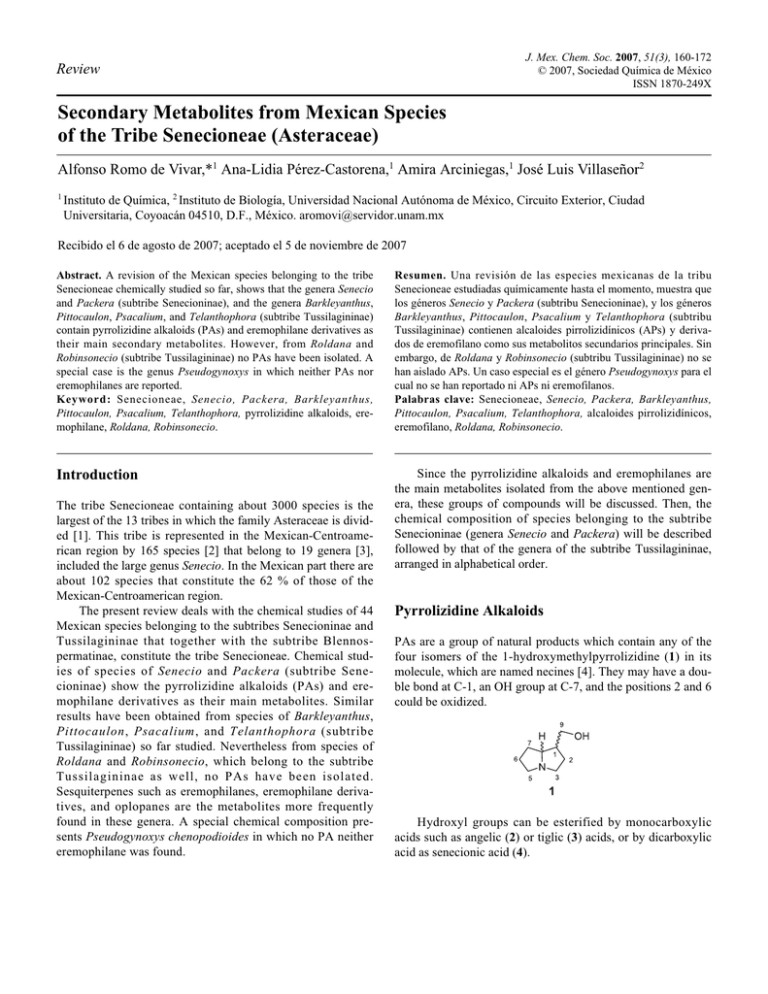
Review Secondary Metabolites from Mexican Species of the Tribe Senecioneae (Asteraceae) J. Mex. Chem. Soc. 2007, 51(3), 160-172 © 2007, Sociedad Química de México ISSN 1870-249X Alfonso Romo de Vivar,*1 Ana-Lidia Pérez-Castorena,1 Amira Arciniegas,1 José Luis Villaseñor2 1 Instituto de Química, 2 Instituto de Biología, Universidad Nacional Autónoma de México, Circuito Exterior, Ciudad Universitaria, Coyoacán 04510, D.F., México. [email protected] Recibido el 6 de agosto de 2007; aceptado el 5 de noviembre de 2007 Abstract. A revision of the Mexican species belonging to the tribe Senecioneae chemically studied so far, shows that the genera Senecio and Packera (subtribe Senecioninae), and the genera Barkleyanthus, Pittocaulon, Psacalium, and Telanthophora (subtribe Tussilagininae) contain pyrrolizidine alkaloids (PAs) and eremophilane derivatives as their main secondary metabolites. However, from Roldana and Robinsonecio (subtribe Tussilagininae) no PAs have been isolated. A special case is the genus Pseudogynoxys in which neither PAs nor eremophilanes are reported. Keyword: Senecioneae, Senecio, Packera, Barkleyanthus, Pittocaulon, Psacalium, Telanthophora, pyrrolizidine alkaloids, eremophilane, Roldana, Robinsonecio. Resumen. Una revisión de las especies mexicanas de la tribu Senecioneae estudiadas químicamente hasta el momento, muestra que los géneros Senecio y Packera (subtribu Senecioninae), y los géneros Barkleyanthus, Pittocaulon, Psacalium y Telanthophora (subtribu Tussilagininae) contienen alcaloides pirrolizidínicos (APs) y derivados de eremofilano como sus metabolitos secundarios principales. Sin embargo, de Roldana y Robinsonecio (subtribu Tussilagininae) no se han aislado APs. Un caso especial es el género Pseudogynoxys para el cual no se han reportado ni APs ni eremofilanos. Palabras clave: Senecioneae, Senecio, Packera, Barkleyanthus, Pittocaulon, Psacalium, Telanthophora, alcaloides pirrolizidínicos, eremofilano, Roldana, Robinsonecio. Introduction Since the pyrrolizidine alkaloids and eremophilanes are the main metabolites isolated from the above mentioned genera, these groups of compounds will be discussed. Then, the chemical composition of species belonging to the subtribe Senecioninae (genera Senecio and Packera) will be described followed by that of the genera of the subtribe Tussilagininae, arranged in alphabetical order. The tribe Senecioneae containing about 3000 species is the largest of the 13 tribes in which the family Asteraceae is divided [1]. This tribe is represented in the Mexican-Centroamerican region by 165 species [2] that belong to 19 genera [3], included the large genus Senecio. In the Mexican part there are about 102 species that constitute the 62 % of those of the Mexican-Centroamerican region. The present review deals with the chemical studies of 44 Mexican species belonging to the subtribes Senecioninae and Tussilagininae that together with the subtribe Blennospermatinae, constitute the tribe Senecioneae. Chemical studies of species of Senecio and Packera (subtribe Senecioninae) show the pyrrolizidine alkaloids (PAs) and eremophilane derivatives as their main metabolites. Similar results have been obtained from species of Barkleyanthus, Pittocaulon, Psacalium, and Telanthophora (subtribe Tussilagininae) so far studied. Nevertheless from species of Roldana and Robinsonecio, which belong to the subtribe Tussilagininae as well, no PAs have been isolated. Sesquiterpenes such as eremophilanes, eremophilane derivatives, and oplopanes are the metabolites more frequently found in these genera. A special chemical composition presents Pseudogynoxys chenopodioides in which no PA neither eremophilane was found. Pyrrolizidine Alkaloids PAs are a group of natural products which contain any of the four isomers of the 1-hydroxymethylpyrrolizidine (1) in its molecule, which are named necines [4]. They may have a double bond at C-1, an OH group at C-7, and the positions 2 and 6 could be oxidized. Hydroxyl groups can be esterified by monocarboxylic acids such as angelic (2) or tiglic (3) acids, or by dicarboxylic acid as senecionic acid (4). Secondary Metabolites from Mexican Species of the Tribe Senecioneae (Asteraceae) PAs containing in their basic skeletons retronecine (5), otonecine (6), or heliotridine (7) are highly toxic. The toxicity increases when a cyclic ester is present as in senecionine (8) which is the more common PA in Senecioneae. 161 insects. The butterflies Danaus gilippus sequester PAs which are used as precursors of their pheromones such as danaidone (10) and hydroxydanaidal (11). The pheromones once synthesized are kept by the male and presented to the female by means of organs it has in the abdomen [6], the females do not accept the males unless they have the odor of the pheromone. The chemical analysis of the body of monarch butterflies (Danaus plexippus) which spend the winter in Mexico [7] showed the presence of the highly toxic PAs: senecionine (8), integerrimine (12a), and seneciphyline (12b), and the open chain PAs intermedine (13a), lycopsamine (13b), and echinatine (13c). All these toxic alkaloids are probably used as defense compounds. Nevertheless, saturated poly-hydroxy PAs mimics the structure of monosacharides and therefore have therapeutic potential in many diseases such as viral infections, cancer and diabetes [5]. Many of the 1,2 dehydro PAs are hepatotoxic, some of them are mutagenic and cause hepatomegalia and venooclusive disorders of the liver among other illnesses. The hazard begins when these substances are converted in the liver to the N-oxides or to hydroxylated compounds α to nitrogen. In both cases an elimination of water led to highly toxic dehydropyrrolizidines [4]. These compounds are electrophiles that could react with nucleophiles such as mercapto, hydroxyl, or amino groups present in enzymes, globulins, or hemoglobin. The purine or pyrimidine of DNA are able to act as nucleophiles creating a stable bridge inside the double helix of DNA (9), thus inducing cancer. Eremophilanes The sesquiterpenes known as eremophilanes contain, in its basic skeleton, a decalin system and most of them are found as furanoeremophilanes (14) or eremophilanolides (15). Eremophilanes could arise from an eudesmane precursor (16) by means of an 1,2 methyl migration, which it has been achieved in vitro by different authors. According to the above discussion, the consumption of herbs which contain PAs should be responsible for health problems and even for numerous deaths of cattle and human beings. However, what is risky for some organisms is good for others. The high toxicity is an advantage for many Kitagawa J. et al. [8] treated the 5,6-epoxi eudesmanolide 17 with formic acid in acetone. The reaction afforded a mixture of eremophilanolides in which the main products were the lactones 18 and 19. 162 J. Mex. Chem. Soc. 2007, 51(3) Some species of Senecioneae contain modified eremophilanes as characteristic metabolites. There are many examples of transformation of eremophilanes into this type of compounds in the chemical literature, as that described by Romo J. [9]. The methylsulfonate of 6-epi-decompostine (20) on heating with collidine afforded the modified eremophilane 21. Further transformation of 21 led to nor-eremophilanes such as 22 which are present in many genera of Senecioneae. Alfonso Romo de Vivar et al. A systematic chemical examination of the section Mulgediifolii began in 1995 with the study of S. mulgediifolius [15]. In this work retroisosenine, its N-oxide, bulgarsenine (25) and mulgediifoline were isolated. Structure 27 was established for mulgediifoline on spectroscopic and chemical grounds, specially by the saponification products, platynecine (28) and cis-nemorencic acid (29). Similar considerations induced to propose structure 30 instead of 24 for retroisosenine. The conformation of retroisosenine (30) was proposed on the basis of its NOE effects, especially those between CH3-18 and H-2 (Fig. 1), which indicated a sandwich conformation with the tetrahydrofuran over the necine. Genus Senecio The genus Senecio includes about 1500 species with a broad spectrum of life forms. It is found world-wide and have in the Mexican-Centroamerican region an important diversification center. Barkley, Clark, and Funston in their study of Senecio sl [3] from the above region, recognized nineteen genera, most of them segregated from Senecio such as Barkleyanthus, Packera, Pittocaulon, Psacalium, Pseudogynoxys, Robinsonecio, Roldana, and Telanthophora. The same authors recognized that the genus Senecio sensu stricto is constituted by six sections; one of them is the section Mulgediifolii which contains 15 species [10] localized from Mexico to Guatemala. Some of its species contain the relative uncommon 13-membered macrocyclic PAs. Until 1995, these compounds have been isolated exclusively from European Senecio species [1114], and only four were known: nemorencine (23), retroisosenine (24), bulgarsenine (25), and doronenine (26). Fig. 1 The chemical examination of the species S. helodes and S. roseus afforded 13-membered macrocyclic PAs [16]. S. helodes yielded 30 and (12S)-12-hydroxyretroisosenine (31), and S. roseus produced 27, 30, 31, and (13R)-13-hydroxyretroisosenine (32). The next species of the section Mulgediifolii chemically analyzed were S. iodanthus and S. bracteatus [17], both species yielded iodanthine (33), bulgarsenine (25), retroisosenine (30), its hydrochloride and that of mulgediifoline (27). Additionally, 31 was obtained from S. bracteatus. 163 Secondary Metabolites from Mexican Species of the Tribe Senecioneae (Asteraceae) The species S. jacalensis [18], S. polypodioides, and S. runcinatus [20] gave 12-membered macrocyclic PAs. S. jacalensis afforded platyphylline (39) and senecionine (8), S. polypodioides yielded 39, its hydrochloride, and its N-oxide, S. runcinatus gave rosmarinine (34) and its N-oxide. The diasteromeric relationship between bulgarsenine (25) and iodanthine (33) afforded differences in the chemical shift of CH2-14 in their respective NMR spectra [17]. Even though the basic hydrolysis of 25 and 33 gave the same necine, platynecine (28), the necic acids were different. The structure of iodanthine was settled as 33 by X-ray crystallographic analysis of its hydrochloride. All Senecio species of the section Mulgediifolii have a restricted distribution, except S. callosus which grows in an extensive area of Central and Southern Mexico. Collections from the States of Mexico, Michoacán and Oaxaca showed a different chemical composition. A sample from a place near Lagunas de Zempoala, State of Mexico, gave a high yield of rosmarinine (34) [18]. The plant collected in Michoacán [19] afforded 11-Oacetyl-bulgarsenine (35a), bulgarsenine (25), callosine (35b), and N-chloromethylbulgarsenine chloride (36). S. callosus from Oaxaca produced the opened chain PAs 37-38a-b. The three species S. doratophyllus, S. conzattii, and S. deformis [21] gave PAs with open chain esters and diesters. S. doratophyllus and S. conzattii afforded sarracine (38a) and neosarracine (38b) as hydrochlorides. Additionally, S. doratophyllus gave 37 and S. conzattii yielded 9-angelylplatynecine (40a) and 7β-tiglylplatynecine (40b). From S. deformis was isolated the 38a N-oxide. In summary, the twelve species of the section Mulgediifolii chemically studied gave PAs. Six of them gave 13-membered macrocyclic PAs, which constitute a relatively uncommon group. Additionally, the five Mexican Senecio species not grouped in the section Mulgediifolii which have been studied chemically (Table 1) exhibited 12-membered macrocyclic PAs with the only exception of S. paricalia. This species was not found in any taxonomic report neither as species nor as synonymous of other species. Table 1. Chemical composition of five Mexican Senecio species. Species S. madrensis Pyrrolizidine alkaloids 8, 39 S. mairetianus 8, 12a S. prionopterus 8, 52 S. pericalia S. procumbens 8, 52, 53 Eremophilane derivatives 41-44 48a-d, 49a-m, 50a-c Diverse compounds 45-47a-e 51a 47f, 51b, 54a Ref 20 22 23 20 24 164 J. Mex. Chem. Soc. 2007, 51(3) Genus Packera Genus Packera was considered as a part of the genus Senecio in a group called Aureoid. The ca. 60 species of the genus Packera [25-26] are distributed from Mexico to arctic regions and the east of Siberia. The genus Packera contains both annual and perennial herbs arising from rootstocks or a caudex, the basal leaves are well developed, the roots are fibrous thin and ramified. Fifteen species and three varieties of Packera are recognized in Mexico but only seven have been studied chemically (Table 2). PAs, eremophilanes, and quinols such as jacaranone (55a) are the main secondary metabolites isolated from Packera species. The quinols are considered responsible of the antitumor properties of the non Mexican species P. fendleri [28]. Alfonso Romo de Vivar et al. It is important to remark that many species of Packera are used as popular medicine, although some contain PAs with hepatotoxic activity. P. candidissima [29] is used by the people of the state of Chihuahua to treat several ailments. The bitter infusion is drunk hot or as drinking water in order to treat kidney disorders and ulcers. The plant contains furanoeremophilanes 56a and 56b, and the PAs senecionine (8), integerrimine (12a), retrorsine (52), usaramine (57), and senkirkine (58), which indicates that users of this herb are at high risk of poisoning. 165 Secondary Metabolites from Mexican Species of the Tribe Senecioneae (Asteraceae) Table 2. Chemical composition of Mexican Packera species. Specie P. bellidifolia P. candidissima P. coahuilensis P. quebradensis P. tampicana P. toluccana P. tomentosa Pyrrolizidine alkaloids Eremophilanes and other sesquiterpenes 8, 12a, 52, 57, 58 8, 52 58, 61 56a-b 56c, 62 63, 64a-e 65a-c, 66 P. toluccana [25] worked as Senecio toluccanus [32, 33] did not show the presence of quinols or PAs, instead it contained furanoeremophilane 6β-hydroxyeuryopsin (63) and eremophilanolides 64a-e. Quinols Diverse compounds 55b 59b 55a-b 55a 59a-b, 60 51a Ref 30 29 30 31 23 32, 33 23 and 67c/68. In a second study, the same authors [31] found the pyrrolizidine alkaloid 7-angelylheliotridine (70). Genus Barkleyanthus Barkleyanthus (Tussilagininae) is a monotypic shrubby genus therefore is constituted of only Barkleyanthus salicifolius. It forms with the genera Pittocaulon, Psacalium, and Robinsonecio a well justified monophyletic group [26]. B. salicifolius, popularly known as jarilla, is a shrub very attractive when covered with yellow flowers at the end of the dry season. The infusion of this herb is used for rheumatism. The first chemical study of B. salicifolius [34] worked as Senecio salignus afforded quercetin (47a). Bohlmann and Zdero [35] isolated in 1976 from the aerial parts of Senecio salignus epoxides 67a and 68. The roots gave mainly the 6-ketofuranoeremophilane 69 and in the polar fractions the mixtures 67b/67c Genus Pittocaulon The genus Pittocaulon (Tussilagininae) is made of only five species, P. bombycophole, P. filare, P. hintonii, P. praecox, and velatum which were segregated from the large genus 166 J. Mex. Chem. Soc. 2007, 51(3) Senecio, [36]. The Pittocaulon popularly known as palo loco are shrubs or small trees growing in somewhat dry rocky places in Central Mexico. They live at altitude of 300 m in dry forests to 3000 m in temperate lands. Probably because the flowers of Pittocaulon appear at the end of the dry season they are called palo loco (crazy plant). P. praecox is the more widely distributed, it can be found from Distrito Federal to regions as far north as Aguascalientes State. P. velatum has after P. praecox the widest range; it grows in Central and Western Mexico. P. filare is restricted to the State of Colima, it is smaller that P. praecox and its leaves are covered with wooly hair, it has beautiful yellow flowers and its seeds are maintained for a long time in the plant. P. bombycophole grows in the States of Michoacán, Guerrero, and Morelos. It has thick trunk and branches, its leaves like those of P. filare are covered with white wooly hair. P. hintonii is restricted to a few localities of States Michoacán and Colima, the species is scarcely ramified and live in small groups where pockets in the rock are filled with soil. P. praecox is the only species of this genus chemically examined. In 1975 [37] the furanoeremophilane pracoxilin A (71) was isolated. The following year Bohlmann and Zdero [35] isolated from the stem furanoeremophilane 72 and two complex mixtures of other furanoeremophilanes, 73a-c and 74a-c. In addition, the roots afforded 73d and the mixtures: 73a-c, 74a-c, 67a-d, and 75a-f. In 2007, Céspedes et al. reported the GC-MS analysis of P. praecox [38]. This analysis permitted to establish the presence of the PAs senecionine (8), integerrimine (12a), platyphylline (39), senkirkine (58), neosenkirkine (76), neoplatyphylline (77), 9-angeloyldihydroxyheliotridane (78a), and 7-angeloyldihydroxyheliotridane (78b) in the plant. These alkaloids are sequestered by the scale insect Alfonso Romo de Vivar et al. Ceroplastes albolineatus which infests the plant. A GC-MS analysis revealed the presence of the 58, 76, 78a, and 78b PAs found in C.albolineatus. Genus Psacalium Genus Psacalium (Tussilagininae) is constituted by 40 species of scapiform perennial herbs distributed from southwest USA to Guatemala [3], most of them endemic to Mexico. Some Psacalium species from Western Sierra Madre are used by Tarahumaras and other Mexicans in the Matarique complex as a popular remedy for diabetes and for kidney ailments [39, 40]. The complex includes Acourtia thurberi and four species of Pscalium: P. decompositum, P. palmeri, P. peltatum, and P. sinuatum. In San Luis Potosí, P. radulifolium is used as a substitute for P. decompositum which is considered the most effective. Even though the matarique complex is used by most Mexicans, the concept of sickness and cure is very especial for tarahumaras who consider that the sickness is due to natural or supernatural reasons. The illness is due to the lost of soul for his own fault or for the action of evil forces. The chaman makes a curative ceremony in search of the lost soul [40]. The reputation of this herbs specially P. decompositum induced J. Romo Armería in 1964, to initiate its chemical study [41]. The analysis of the roots of P. decompositum led to the isolation of the sesquiterpenes cacalol and cacalone whose structures were proposed as 79 and 80, respectively. Later, these structures were revised to 81 [42] and 82 [43]. In a second study, Correa and Romo [44] isolated, from the same plant, four cacalol derivatives called maturin (83a), maturinin (83b), maturinone (84a), and maturone (84b). In the same study, the acetal 85 which is probably an artifact formed by the reaction between two molecules of maturin (83a) was isolated. The isolation of the furanoeremophilane decompostin (86) [45] indicates a biogenetic relationship between the eremophilanes and the cacalol derivatives which are common in Psacalium. Secondary Metabolites from Mexican Species of the Tribe Senecioneae (Asteraceae) 167 P. radulifolium is one of the species of the matarique complex, which is used for treatment of diabetes. A chemical study of the less polar constituent of roots from this species [52] afforded cacalol (81), cacalone (82), epi-cacalone (88), decompostin (86), O-methyl-1,2-dehydrocacalol (91), neoadenostylone (92), adenostin A (93), radulifolin A (94a), epi-radulifolin A (94b), radulifolin B (95), and radulifolin C (96a). Additionally, it was established the antimicrobial activity of cacalol. After several modifications, the structures were well established by Kakisawa, Inouye, and Romo [42]. They made correlations with furanoeremophilane derivatives and also made the total synthesis. Moreover, the absolute stereochemistry was established by Tarabe et al. [46]. In 1977, Jiménez-Estrada et al. [47] found in roots of P. decompositum the hydroperoxide 87 and a mixture of cacalone (82) and its epimer 88, and in 2000, they obtained from the same species [48], the quinone 13-dehydromaturone 89 which was called romo A. On the other hand, Inman et al. [49] reported in 1999, the antihyperglycemic activity of an aqueous extract of roots of P. decompositum. They isolated 81, 82, 88, and a mixture 1:1 of 3-hydroxycacalolide (90a) and epi-3-hydroxycacalolide (90b) and described that 81 and the mixture 90a/90b resulted active in diabetic mice. They also reported the presence of PAs which were only detected by TLC. More recently, AlarconAguilar et al. [50] tested the hypoglycemic activity of the aqueous extract of P. decompositum and that of its main metabolites 81, 82, and 83a. The extract resulted active and the main metabolites inactive. The precipitate obtained from the dried water extract after treatment with methanol caused a significant decrease in fasting glycemia. In 2006, JiménezEstrada et al. [51] described the anti-inflammatory activity of 81 and 82. In a second work of P. radulifolium [53], the more polar extracts of roots were purified and yielded the modified eremophilanes: 81, 82, 83c, 84a, 85, 86, 88, 90a-b, 91, radulifolins C-F (96a,b-98a), and epi-radulifolin F (98b). The extracts of this plant and some of its metabolites were evaluated as hypoglucemic and antihyperglycemic agents, but only the methanol extract displayed hypoglycemic activity. The anti-oxidant activity of the cacalol (81) was also reported. Analysis of P. beamanii [54] afforded the phenylethanoid icariside D2 (99) and the modified eremophilanes: maturin (83a), maturin acetate (83c), maturinone (84a), maturone (84b), maturone acetate (84c), decompostin (86), cacalonol (100a/100b), and peroxycacalonol (100c/100d). 168 J. Mex. Chem. Soc. 2007, 51(3) The aerial parts of P. megaphyllum [55] afforded kaempferol-3-O-α-L-(3-O-acetyl)rhamnopyranoside-7-O-αL-rhamnopyranoside (101a). No sesquiterpenes were found. A chemical study of P. paucicapitatum [56], commonly known in Oaxaca state as hierba del venado and used as antiinflammatory, revealed the presence of the furanoeremophilanone 102 and of four eremophilanolides 103-104a-c; thus, differing from the chemical composition of other Psacalium species whose characteristic metabolites are the modified eremophilanes, also known as cacalol derivatives. Alfonso Romo de Vivar et al. The chemical examination of leaves, roots, and rhizome of R. gerberifolius [59] collected near the alpine refuge of Pico de Orizaba at 4150 m, in October 2000, resulted in the isolation of two oplopanes (107a-b) and five eremophilane derivatives (108-110). The presence of oplopanes in the genus Robinsonecio may have chemosystematic significance. Nevertheless, it is important to mention that this kind of compounds have been isolated from Roldana mexicana (Table 3) [60-62] and from several species of Senecio such as S. ovirensis (111a-b) [63] and S. kleinia (112a-b) [64]. Genus Pseudogynoxys Pseudogynoxys is constituted by 13 species distributed from Mexico to Guatemala [57]. The genus contains shrubby plants with orange flowers that become reddish with age; in some species the flowers are fragrant. P. chenopodioides is one of the four species that grow in Mexico (P. fragans, P. chenopodiodes, P. cummingii, and P. haenkei) which has been cultivated. Therefore its distribution might be partially the result of human intervention. A collection from the State of Nuevo Leon worked as Senecio confusus [23] resulted in the isolation of the germacrene D derivative (105) and the quinols 55a-b and 106. Genus Robinsonecio Robinsonecio (subtribe Tussilagininae) is a genus of perennial herbs segregated from Senecio and established in 1996 by Barkey and Janovec [58]. The two new combinations proposed were Robinsonecio gerberifolius and Robinsonecio porphyrestes. In a second work on R. gerberifolius [65], saponification of compounds 108a-b yielded the expected diol 113 and the pair of epimers 114a-b, in which a rearrangement and an elimination have occurred. The diketo compound 115 was formed by autooxidation of 108a followed by β-elimination of the C-3 ester. Basic hydrolysis of the hydroperoxide 109b gave compounds 109a, 116 and 117. The last substance was produced by a rearrangement in which the OH group at C-1 was oxidized to a keto group with an elimination of the ester at C-3. In addition, the double bond at C-9 was reduced and the peroxide added to the C-6 double bond. 169 Secondary Metabolites from Mexican Species of the Tribe Senecioneae (Asteraceae) Genus Roldana Roldana (subtribe Tussilagininae) is constituted of 48 species distributed from southeastern Arizona and southern New Mexico to Panama. These plants vary from low herbs of no more than 1 m tall to shrubs or trees that may reach 12 m tall and grow mostly in temperate forests at altitudes from 1000 to 4000 m. The genus has two centers of diversity in Mexico, one along the Volcanic Belt and Sierra Madre del Sur and the second along Sierra Madre de Chiapas [66]. The Mexican Tussilaginoid genera associated to Roldana are Barkleyanthus, Pittocaulon, Psacalium, and Villasenoria. The chemical studies of Roldana have been carried out preferentially on the roots and the secondary metabolites more frequently found have been sesquiterpenes with variable structures, specially furanoeremophilanes and modified eremophilanes. The metabolites isolated from the aerial parts present diverse structures and some of them with important biological activities. One of the more studied species is R. barba-johannis [6769]. In 2003, several compounds from its aerial parts were reported, among them 3 plastoquinone derivatives (118-120) [68] with anti-inflammatory and antioxidant activities. These compounds were also tested as insect growth inhibitors [69]. Table 3. Chemical composition of Mexican Roldana species. Species [Ref] R. angulifolia roots [73] aerial parts [73] R. aschenborniana aerial parts [23,74] R. barba-johannis roots[67 aerial parts [68,69] R. ehrenbergiana roots [75,76] leaves [75] flowers [76] R. heterogama roots [77] R. lineolata roots [78,79] aerial parts [78] R. mexicana roots [60,61] leaves [629] R. sessilifolia roots [70-72] R. sundbergii aerial parts [23] Eremophilane derivatives 126 They showed selective effects on the pre-emergence metabolism of the Fall armyworm (Spodoptera fungiperda J. F. Smith) which is an important pest of corn. Other example is Roldana sessilifolia which belongs to the Cachana complex of medicinal plants [70]. This complex is used to treat some female ailments. The roots of Roldana sessilifolia [70-72] afforded the eremophilanolides 103, 104ac, and 121a-c. The results obtained from nine Mexican Roldana species, mainly of the roots, are shown in table 3. Modified eremophilanes Oplopanes 83c,122-124a-c 125 47g,54a-b,127 56a,128a-f,129 64b 101b-c,130-135a-b 124b-d 118-120a-b, 136a-b 137a-b-139a-b 48b,48d,49k,49n 103,104a-c,121a-c Diverse compounds 47h,140 136a-b 81,83b,91,124b, 141a-b 142-146 142a-b,144,147 47i-j,136a-b 47h 51a,130,131,148 170 J. Mex. Chem. Soc. 2007, 51(3) Alfonso Romo de Vivar et al. Secondary Metabolites from Mexican Species of the Tribe Senecioneae (Asteraceae) Genus Telanthophora Telanthophora (Tussilagininae) includes 14 species of shrubs or trees distributed from northern Mexico to Panama [3]. Until the present time the only two species chemically analyzed are T. grandifolia [31], formerly Senecio grandifolius, and T. andrieuxii [80]. The chemical study of T. grandifolia, which is the most widespread of the genus, afforded the PAs senkirkine (64) and neosenkirkine (82) and the 9-ketofuranoeremophilanes 149a-h. The species T. andrieuxii was worked as Senecio andreuxii and yielded compounds 150-152. Considering the species of Telanthophora studied so far, the 9-ketofuranoeremofilane derivatives can be considered as the characteristic metabolites of the genus. References 1. Heywood, V. H.; Harborne, J. B. The Biology and Chemistry of Compositae. Academic Press, London 1977. 2. Barkley, A. M. A Geo-Historial Perspective on the Distribution and Variation in Senecio s.l. (Asteraceae, Senecioneae) in Mexico and C. America. In: PI. Syst. Evol. [supl. 4.] 1995, 113119. 3. Barkley, T. M.; Clark, B. L.; Funston, A. M. Proceedings of the International Compositae Conference, Vol. 1, Kew Gardens, 1994, Hind D. J. M. Editor, Royal Botanical Gardens Kew, 1996, 613-620. 4. Roeder, E. Pharmazie 1995, 50, 83-98. 5. Asano, N.; Nash, R. J.; Molineax, R. J.; Fleet, W. J. Tetrahedron Asymmetr. 2000, 11, 1645-1680. 171 6. Schneider, D. Naturwissenschaften 1992, 79, 241-250. 7. Kelley, R. B.; Seiber, J. N.; Jones, A. D.; Segall, H. J.; Brower, L. P. Experientia 1987, 43, 943-946. 8. Kitagawa, I.; Shibuya, H.; Takeno, H.; Nishino, T.; Yoshioka, I. Chem. Pharm. Bull. 1976, 24, 56-60. 9. Romo, J. Bol. Inst. Quím. Univ. Nac. Autón. Méx. 1969, 21, 9296. 10. Villaseñor, J. L. The Systematic of Senecio, Section Mulgediifolii (Asteraceae: Senecineae). Ph. Dissertation. The Claremont Graduate School, Claremont California, 1991. 11. Roeder, E.; Wiedenfeld, H.; Friese, M. Phytochemistry 1980, 19, 1275-1277. 12. Klasek, A.; Sedmera, P.; Boeva, A.; Santavy, F. Coll. Czech. Chem. Commun. 1973, 38, 2504-2512. 13. Nguyen, T. N.; Sedmera, P.: Klasek, A.; Boeva, A.; Dryanovska, L.; Dolejs, L.; Santavy, F.; Coll. Czech. Chem. Commun. 1976, 41, 2952-2963. 14. Klasek, A.; Sedmera, P.; Vokaun, J.; Boeva, A.; Dvovaekova, S.; Santana, F. Coll. Czech. Chem. Commun. 1980, 45, 548-558. 15. Romo de Vivar, A.; Pérez-Castorena, A. L.; Arciniegas, A.; Vidales, P.; Gaviño, R.; Villaseñor, J. L. Tetrahedron 1995, 51, 12521-12528. 16. Pérez-Castorena, A. L.; Arciniegas, A.; Castro, A.; Villaseñor, J. L.; Toscano, R. A.; Romo de Vivar, A. J. Nat. Prod. 1997, 60, 1332-1325. 17. Pérez-Castorena, A. L.; Pérez-Gutiérrez, H.; Villaseñor, J. L.; Toscano, R. A.; Romo de Vivar, A. J. Nat. Prod. 1999, 62, 10391043. 18. Romo de Vivar, A.; Pérez-Castorena, A. L.; Vidales, P.; Villaseñor, J. L. Biochem. Syst. Ecol. 1996, 24, 175-176. 19. Pérez-Castorena, A. L.; Arciniegas, A.; Villaseñor, J. L.; Romo de Vivar, A. J. Nat. Prod. 1998, 61, 1288-1291. 20. Pérez-Castorena, A. L.; Arciniegas, A.; Martínez, F.; Villaseñor, J. L.; Romo de Vivar, A.; Biochem. Syst. Ecol. 2000, 28, 279282. 21. Pérez-Castorena, A. L.; Arciniegas, A.; Villaseñor, J. L.; Romo de Vivar, A. Biochem. Syst. Ecol. 1999, 27, 835-837. 22. Pérez-Castorena, A. L.; Arciniegas, A.; Guzmán, S. L.; Villaseñor, J. L.; Romo de Vivar, A.; J. Nat. Prod. 2006, 69, 1471-1475. 23. Mericli, A. H.; Mericli, F.; Jakupovic, J.; Bohlmann, F.; Dominguez, X. A.; Vega, H. S.; Phytochemisty 1989, 28, 11491153. 24. Arciniegas, A.; Pérez-Castorena, A. L.; Villaseñor, J. L.; Romo de Vivar, A. J. Mex. Chem. Soc. 2005, 49, 284-286. 25. Weber, W.; Lóve, A. Phytologia 1981, 49, 44-50. 26. Bain, J. F.; Golden, J. L. Mol. Phyl. Evol. 2000, 331-338. 27. Freeman, C. C.; Barkley, T. M. Sida 1995, 16, 699-709. 28. Pettit, G. R.; Einck, J. J.; Brown, P.; Harvey, T. B.; Ode, R. H.; Pase, C. P. J. Nat. Prod. 1980, 43, 609-616. 172 J. Mex. Chem. Soc. 2007, 51(3) 29. Bah, M.; Bye, R.; Pereda-Miranda, R. J. Ethnopharmacology 1994, 43, 19-30. 30. Pérez-Castorena, A. L.; Arciniegas, A.; Martínez, F.; Márquez, C.; Villaseñor, J. L.; Romo de Vivar, A. Biochem. Syst. Ecol. 2001, 29, 203-206. 31. Bohlmann, F.; Zdero, C.; Jakupovic, J.; Grenz, M.; Castro, V.; King, R. M.; Robinson, H.; Vincent, L. P. D. Phytochemistry 1986, 25, 1151-1159. 32. Pérez-Castorena, A. L.; Vidales, P.; Cárdenas, J.; Romo de Vivar, A. Phytochemistry 1991, 30, 905-908. 33. Arciniegas, A.; Pérez-Castorena, A. L.; Parada, R.; Villaseñor, J. L.; Romo de Vivar, A. Rev. Latinoamer. Quim. 2000, 28, 131136. 34. Rodríguez, J.; Tello, H.; Quijano, L.; Calderón, J.; Gómez, F.; Romo, J.; Ríos, T. Rev. Latinoamer. Quim., 1974, 5, 41-53. 35. Bohlmann, F.; Zdero, C. Chem. Ber. 1976, 109, 819-825. 36. Robinson, H.; Brettell, R. D. Phytologia 1973, 26, 451-453. 37. Ortega, A.; Romero, M.; Díaz, E. Rev. Latinoamer. Quim. 1975, 6, 136-142. 38. Marín, L. J. C.; Céspedes, C. L.; Beuerle, T.; Theuring, C.; Hartmann, T. Chemoecology 2007, 17, 109-115. 39. Linares, E.; Bye, R. J. Ethnopharmacol. 1987, 19, 153-183. 40. Bye, R. A. Econ. Bot. 1986, 40, 103-104. 41. Romo, J.; Joseph-Nathan, P. Tetrahedron 1964, 20, 2331-2337. 42. Kakisawa, H.; Inouye, Y.; Romo A., J. Tetrahedron Letters 1969, 1929-1932. 43. Casares, A.; Maldonado, L. A. Tetrahedron Letters 1976, 24852488. 44. Correa, J.; Romo, J. Tetrahedron 1966, 22, 685-691. 45. Rodríguez-Hahn, L.; Guzmán, A.; Romo, J. Tetrahedron 1968, 24, 477-483 46. Tarabe, M.; Tada, M.; Takahashi, T. Bull. Chem. Soc. Jap. 1978, 51, 661-662. 47. Jiménez-Estrada, M.; Navarro-Ocaña, A.; Villanueva, E.; Paredes-González, B.; Reyes-Chilpa, R.; Román-Ramos, R.; Alarcón, F. Planta Med. 1997, 63, 387-388. 48. Reyes-Chilpa, R.; Jiménez-Estrada, M.; Godínez, M. V.; Hernández-Ortega, S.; Campos, M.; Béjar, E. Nat. Prod. Lett. 2002, 16, 239-242. 49. Inman, W. D.; Luo, J.; Jolad, S. D.; King, S. R.; Cooper, R. J. Nat. Prod. 1999, 62, 1088-1092. 50. Alarcón-Aguilar, F. J.; Jiménez-Estrada, M.; Reyes-Chilpa, R.; Gonzalez-Paredes, B.; Contreras-Weber, C. C.; Roman-Ramos, R. J. Ethnopharmacol. 2000, 69, 207-215. 51. Jiménez-Estrada, M.; Reyes-Chilpa, R.; Ramírez, A. T.; Lledias, F.; Hansberg, W.; Arrieta, D.; Alarcón-Aguilar, F. J. J. Ethnopharmacol. 2006, 105, 34-38. 52. Garduño-Ramírez, M. L.; Trejo, A.; Navarro, V.; Bye, R.; Linares, E.; Delgado, G. J. Nat. Prod. 2001, 64, 432-435. 53. Garduño-Ramírez, M. L.; Delgado, G. Rev. Soc. Quím. Méx. 2003, 47, 160-166. 54. Pérez-Castorena, A. L.; Arciniegas, A.; Villaseñor, J. L.; Romo de Vivar, A. Rev. Soc. Quim. Mex. 2004, 48, 21-23. Alfonso Romo de Vivar et al. 55. Pérez-Castorena, A. L.; Castro, A.; Romo de Vivar, A. Phytochemistry 1997, 46,1297-1299. 56. Burgueño-Tapia, E.; Hernández-Carlos, B.; Joseph-Nathan, P. J. Mol. Struct. 2006, 825, 115-123. 57. Robinson, H.; Cuatrecasa J. Phytologia 1977, 36, 177-191. 58. Barkley, T. M.; Janovec, J. P. Sida 1996, 17, 77-81. 59. Arciniegas, A.; Pérez-Castorena, A. L.; Reyes, S.; Contreras, J. L.; Romo de Vivar, A. J. Nat. Prod. 2003, 66, 225-229. 60. Joseph-Nathan, P.; Villagómez, J. R.; Román, L. V.; Hernández, J. D. Phytochemistry 1989, 28, 1207-1208. 61. Joseph-Nathan, P.; Villagómez, J. R.; Rojas-Gardida, M.; Román, L. V.; Hernández, J. D. Phytochemistry 1989, 28, 23972401. 62. Joseph-Nathan, P.; Villagómez, J. R.; Román, L. V.; Hernández, J. D. Phytochemistry 1990, 29, 977-979. 63. Bohlmann, F.; Mahanta, P. Phytochemistry 1979, 18, 678-680. 64. Bohlmann, F.; Zdero, C.; Gupta, R. K. Phytochemistry 1981, 20, 2024-2026. 65. Arciniegas, A.; Pérez-Castorena, A. L.; Cuevas, G.; Río-Portilla, F.; Romo de Vivar, A. Magn. Res. Chem. 2006, 44, 30-34. 66. Funston, A. M. A Review of the Genus Roldana (Asteraceae: Senecioneae), Ph.Dr. Dissertation, Kansas State University Ks USA, 1999. 67. Burgueño-Tapia, E.; Joseph-Nathan, P. Magn. Res. Chem. 2003, 41, 386-390. 68. Pérez-Castorena, A. L.; Arciniegas, A.; Ramírez, A. M. T.; Villaseñor, J. L.; Romo de Vivar, A. Planta Med. 2002, 68, 645647. 69. Céspedes, C. L.; Torres, P.; Marín, J. C.; Arciniegas, A.; Romo de Vivar, A.; Perez-Castorena, A. L.; Aranda, E. Phytochemistry 2004, 65, 1963-1975. 70. Delgado, G.; García, P. E.; Bye, R. A.; Linares, E. Phytochemistry 1991, 30, 1716-1719. 71. Delgado, G.; García, P. E. Planta Med. 1993, 59, 389. 72. Delgado, G.; García, P. E.; Roldan, R. I.; Bye, R.; Linares, E. Nat. Prod. Lett. 1996, 8, 145-150. 73. Arciniegas, A.; Pérez-Castorena, A. L.; Villaseñor, J. L.; Romo de Vivar, A. J. Nat. Prod. 2006, 69, 1826-1829. 74. Arciniegas, A.; Pérez-Castorena A. L., Villaseñor J. L., Romo de Vivar A. Biochem. Syst. Ecol. 2004, 32, 615-618. 75. Pérez-Castorena, A. L.; Arciniegas, A.; Hernández, M. L.; de la Rosa, I.; Contreras, J. L.; Romo de Vivar, A. Z. Naturforschung B 2005, 60, 1088-1092. 76. Pérez-Castorena, A. L.; Arciniegas, A.; Hernández, M. L.; Toscano, R. A.; Contreras, J. L.; Romo de Vivar, A. J. Mex. Chem. Soc. 2006, 50, 157-159. 77. Bohlmann, F.; Zdero, C. Phytochemistry 1978, 17, 565-566. 78. Arciniegas, A.; Pérez-Castorena, A. L.; Maldonado, J.; Ávila, G.; Villaseñor, J. L.; Romo de Vivar, A. Fitoterapia 2007, in press. 79. Burgueño-Tapia, E.; López-Escobedo, S.; González-Ledesma, M.; Joseph-Nathan, P. Magn. Res. Chem. 2007, 45, 457-462. 80. Reyes, B.; Delgado, G. Heterocycles 1990, 31, 1405-1408.
